Library Management System Report: Data Modeling and UML Diagrams
VerifiedAdded on 2022/10/07
|15
|1254
|45
Report
AI Summary
This report details the design and analysis of a Library Management System (LMS). It begins with an introduction and justification for the system, highlighting the advantages of an online LMS over manual operations, including reduced costs, better record-keeping, and increased user capacity. The project scope is defined, followed by a cost and schedule analysis. The core of the report involves process and data modeling, utilizing UML diagrams such as use case and sequence diagrams to illustrate system interactions. Data flow diagrams (DFD level 0 and context diagram) are used to show the flow of information, and an entity-relationship diagram (ERD) models the data requirements, ensuring the data is in 2nd Normal Form. Screen interfaces are provided to showcase the system's user interface, and a Gantt chart illustrates the project schedule. The report concludes by emphasizing the benefits of the system and the need for thorough testing before implementation. References to supporting literature are included.
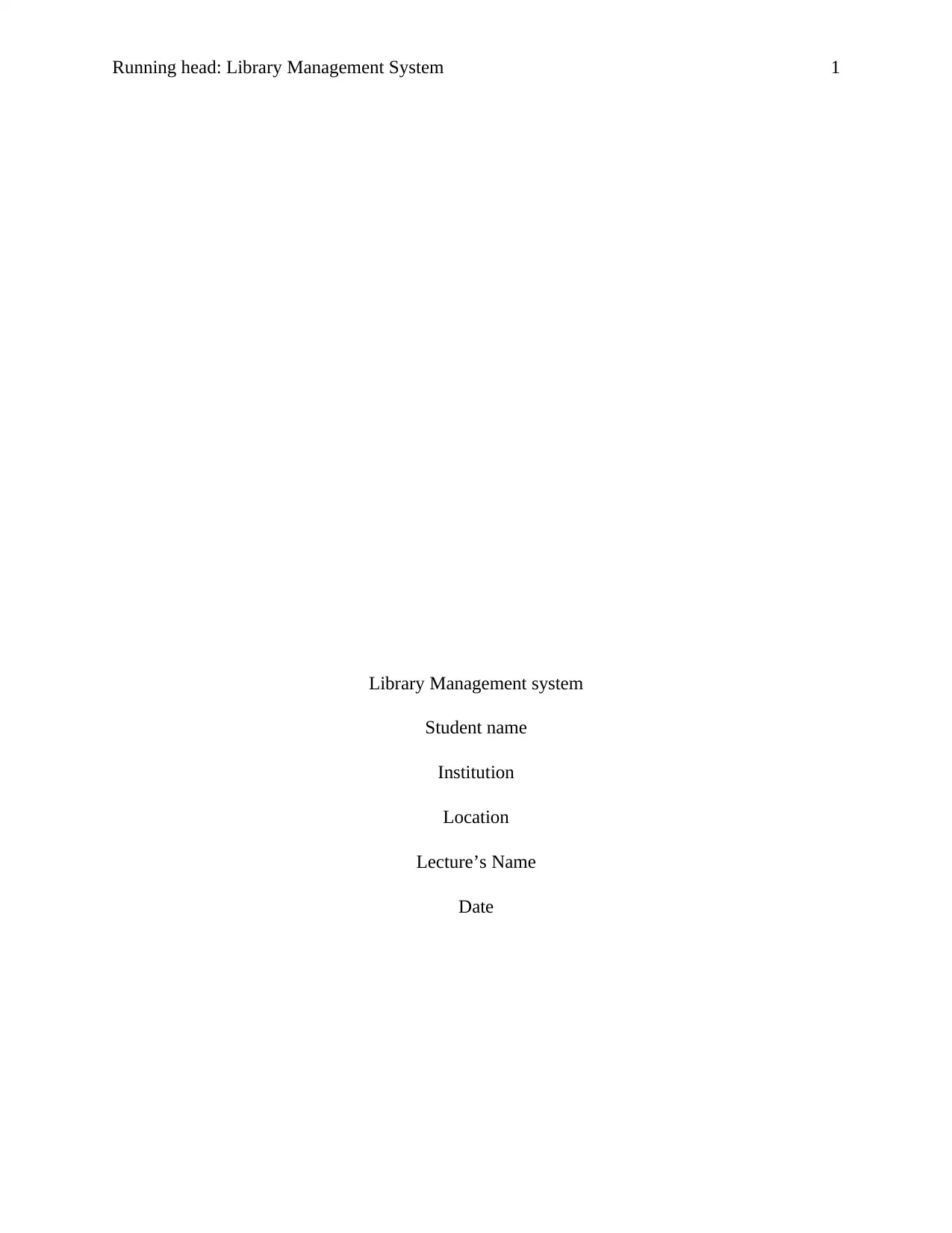
Running head: Library Management System 1
Library Management system
Student name
Institution
Location
Lecture’s Name
Date
Library Management system
Student name
Institution
Location
Lecture’s Name
Date
Paraphrase This Document
Need a fresh take? Get an instant paraphrase of this document with our AI Paraphraser
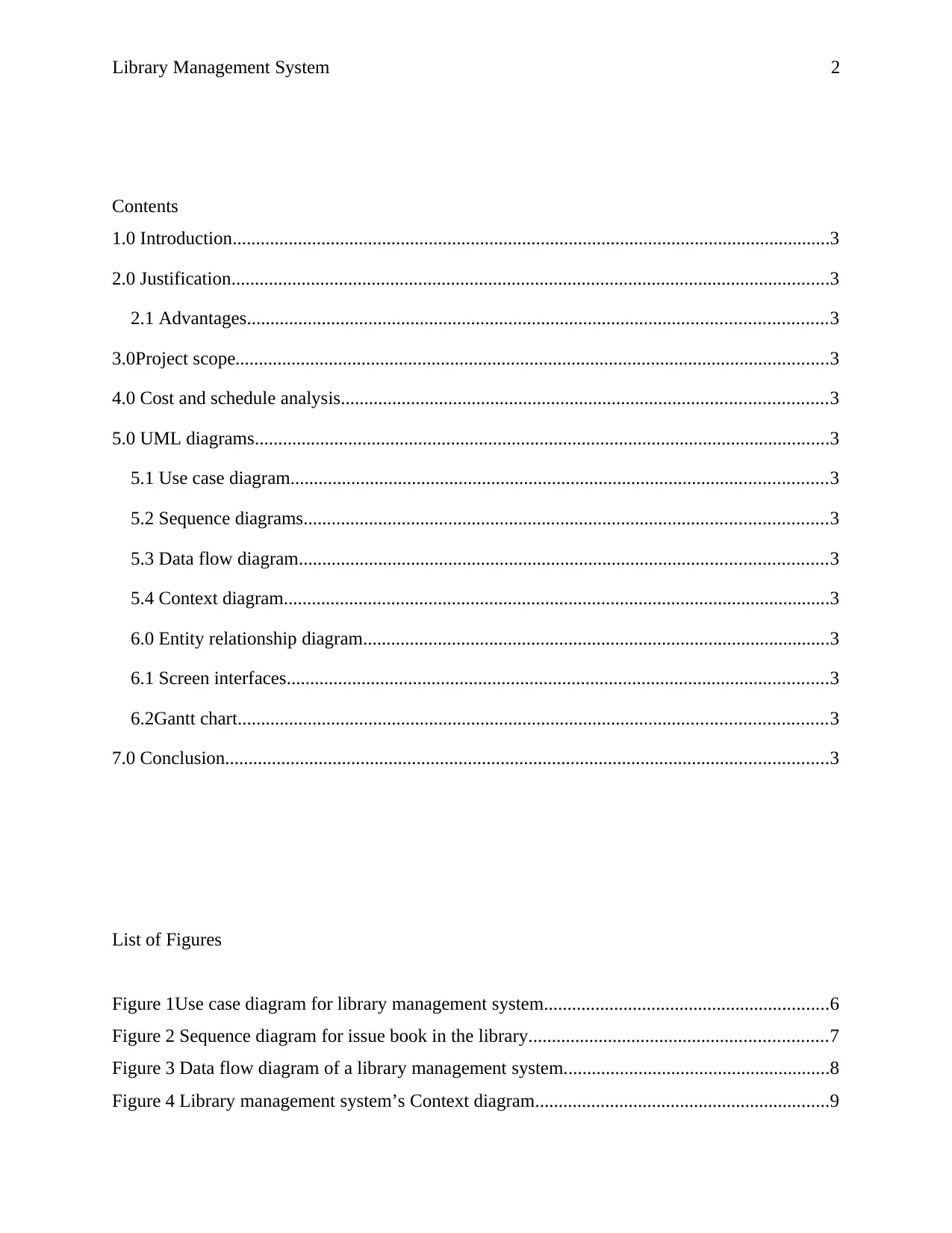
Library Management System 2
Contents
1.0 Introduction................................................................................................................................3
2.0 Justification................................................................................................................................3
2.1 Advantages............................................................................................................................3
3.0Project scope...............................................................................................................................3
4.0 Cost and schedule analysis........................................................................................................3
5.0 UML diagrams...........................................................................................................................3
5.1 Use case diagram...................................................................................................................3
5.2 Sequence diagrams................................................................................................................3
5.3 Data flow diagram.................................................................................................................3
5.4 Context diagram.....................................................................................................................3
6.0 Entity relationship diagram....................................................................................................3
6.1 Screen interfaces....................................................................................................................3
6.2Gantt chart..............................................................................................................................3
7.0 Conclusion.................................................................................................................................3
List of Figures
Figure 1Use case diagram for library management system.............................................................6
Figure 2 Sequence diagram for issue book in the library................................................................7
Figure 3 Data flow diagram of a library management system.........................................................8
Figure 4 Library management system’s Context diagram...............................................................9
Contents
1.0 Introduction................................................................................................................................3
2.0 Justification................................................................................................................................3
2.1 Advantages............................................................................................................................3
3.0Project scope...............................................................................................................................3
4.0 Cost and schedule analysis........................................................................................................3
5.0 UML diagrams...........................................................................................................................3
5.1 Use case diagram...................................................................................................................3
5.2 Sequence diagrams................................................................................................................3
5.3 Data flow diagram.................................................................................................................3
5.4 Context diagram.....................................................................................................................3
6.0 Entity relationship diagram....................................................................................................3
6.1 Screen interfaces....................................................................................................................3
6.2Gantt chart..............................................................................................................................3
7.0 Conclusion.................................................................................................................................3
List of Figures
Figure 1Use case diagram for library management system.............................................................6
Figure 2 Sequence diagram for issue book in the library................................................................7
Figure 3 Data flow diagram of a library management system.........................................................8
Figure 4 Library management system’s Context diagram...............................................................9
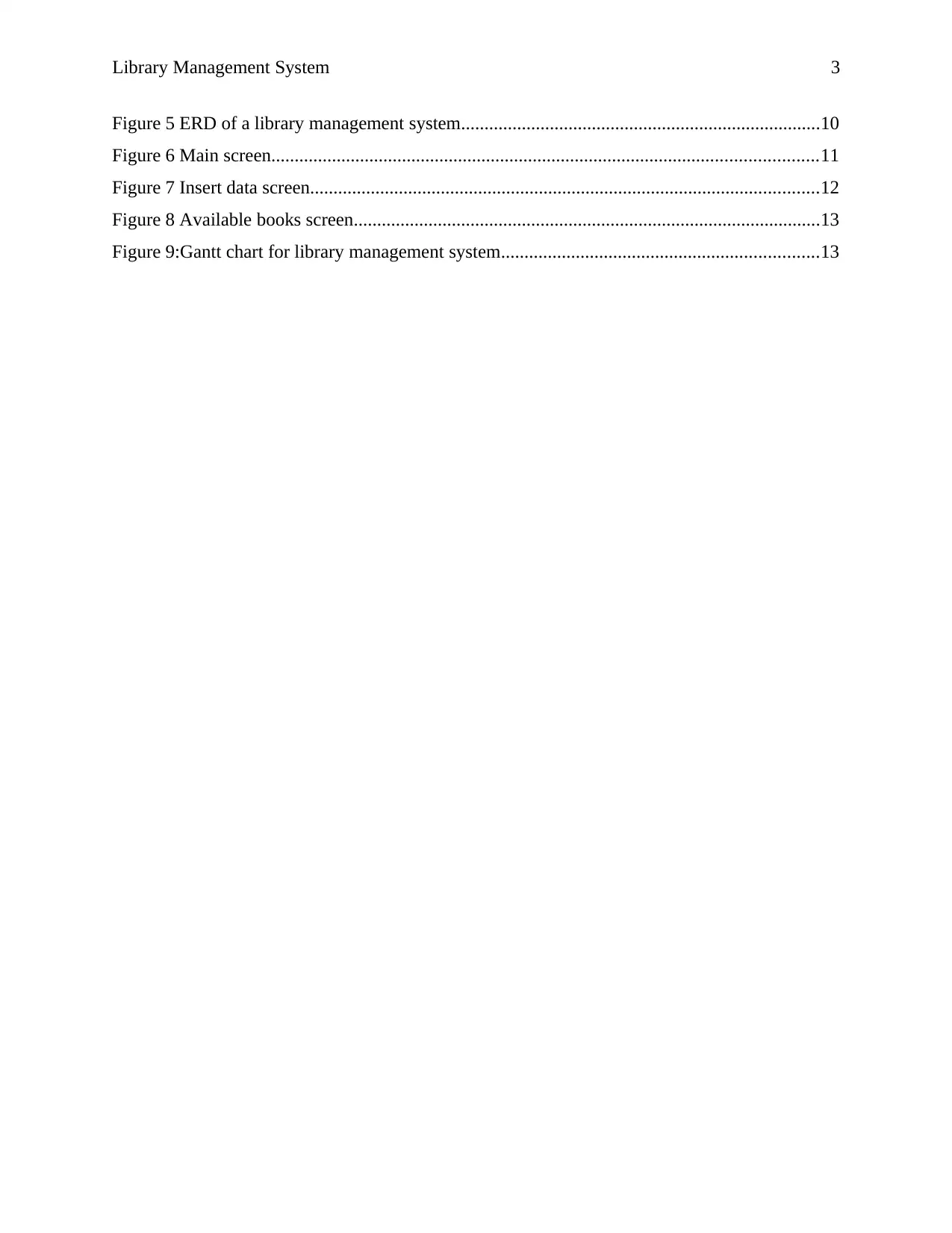
Library Management System 3
Figure 5 ERD of a library management system.............................................................................10
Figure 6 Main screen.....................................................................................................................11
Figure 7 Insert data screen.............................................................................................................12
Figure 8 Available books screen....................................................................................................13
Figure 9:Gantt chart for library management system....................................................................13
Figure 5 ERD of a library management system.............................................................................10
Figure 6 Main screen.....................................................................................................................11
Figure 7 Insert data screen.............................................................................................................12
Figure 8 Available books screen....................................................................................................13
Figure 9:Gantt chart for library management system....................................................................13
⊘ This is a preview!⊘
Do you want full access?
Subscribe today to unlock all pages.

Trusted by 1+ million students worldwide
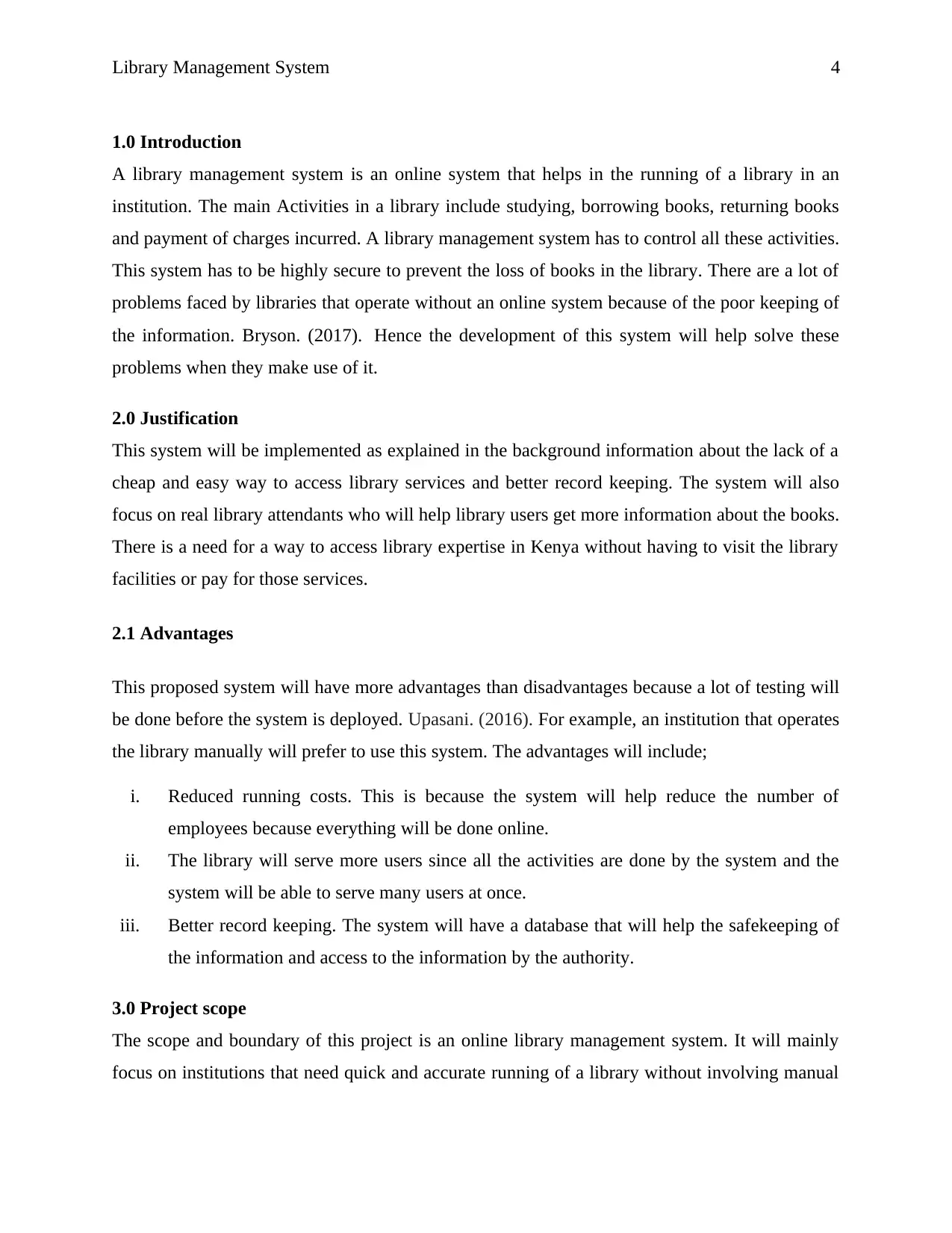
Library Management System 4
1.0 Introduction
A library management system is an online system that helps in the running of a library in an
institution. The main Activities in a library include studying, borrowing books, returning books
and payment of charges incurred. A library management system has to control all these activities.
This system has to be highly secure to prevent the loss of books in the library. There are a lot of
problems faced by libraries that operate without an online system because of the poor keeping of
the information. Bryson. (2017). Hence the development of this system will help solve these
problems when they make use of it.
2.0 Justification
This system will be implemented as explained in the background information about the lack of a
cheap and easy way to access library services and better record keeping. The system will also
focus on real library attendants who will help library users get more information about the books.
There is a need for a way to access library expertise in Kenya without having to visit the library
facilities or pay for those services.
2.1 Advantages
This proposed system will have more advantages than disadvantages because a lot of testing will
be done before the system is deployed. Upasani. (2016). For example, an institution that operates
the library manually will prefer to use this system. The advantages will include;
i. Reduced running costs. This is because the system will help reduce the number of
employees because everything will be done online.
ii. The library will serve more users since all the activities are done by the system and the
system will be able to serve many users at once.
iii. Better record keeping. The system will have a database that will help the safekeeping of
the information and access to the information by the authority.
3.0 Project scope
The scope and boundary of this project is an online library management system. It will mainly
focus on institutions that need quick and accurate running of a library without involving manual
1.0 Introduction
A library management system is an online system that helps in the running of a library in an
institution. The main Activities in a library include studying, borrowing books, returning books
and payment of charges incurred. A library management system has to control all these activities.
This system has to be highly secure to prevent the loss of books in the library. There are a lot of
problems faced by libraries that operate without an online system because of the poor keeping of
the information. Bryson. (2017). Hence the development of this system will help solve these
problems when they make use of it.
2.0 Justification
This system will be implemented as explained in the background information about the lack of a
cheap and easy way to access library services and better record keeping. The system will also
focus on real library attendants who will help library users get more information about the books.
There is a need for a way to access library expertise in Kenya without having to visit the library
facilities or pay for those services.
2.1 Advantages
This proposed system will have more advantages than disadvantages because a lot of testing will
be done before the system is deployed. Upasani. (2016). For example, an institution that operates
the library manually will prefer to use this system. The advantages will include;
i. Reduced running costs. This is because the system will help reduce the number of
employees because everything will be done online.
ii. The library will serve more users since all the activities are done by the system and the
system will be able to serve many users at once.
iii. Better record keeping. The system will have a database that will help the safekeeping of
the information and access to the information by the authority.
3.0 Project scope
The scope and boundary of this project is an online library management system. It will mainly
focus on institutions that need quick and accurate running of a library without involving manual
Paraphrase This Document
Need a fresh take? Get an instant paraphrase of this document with our AI Paraphraser
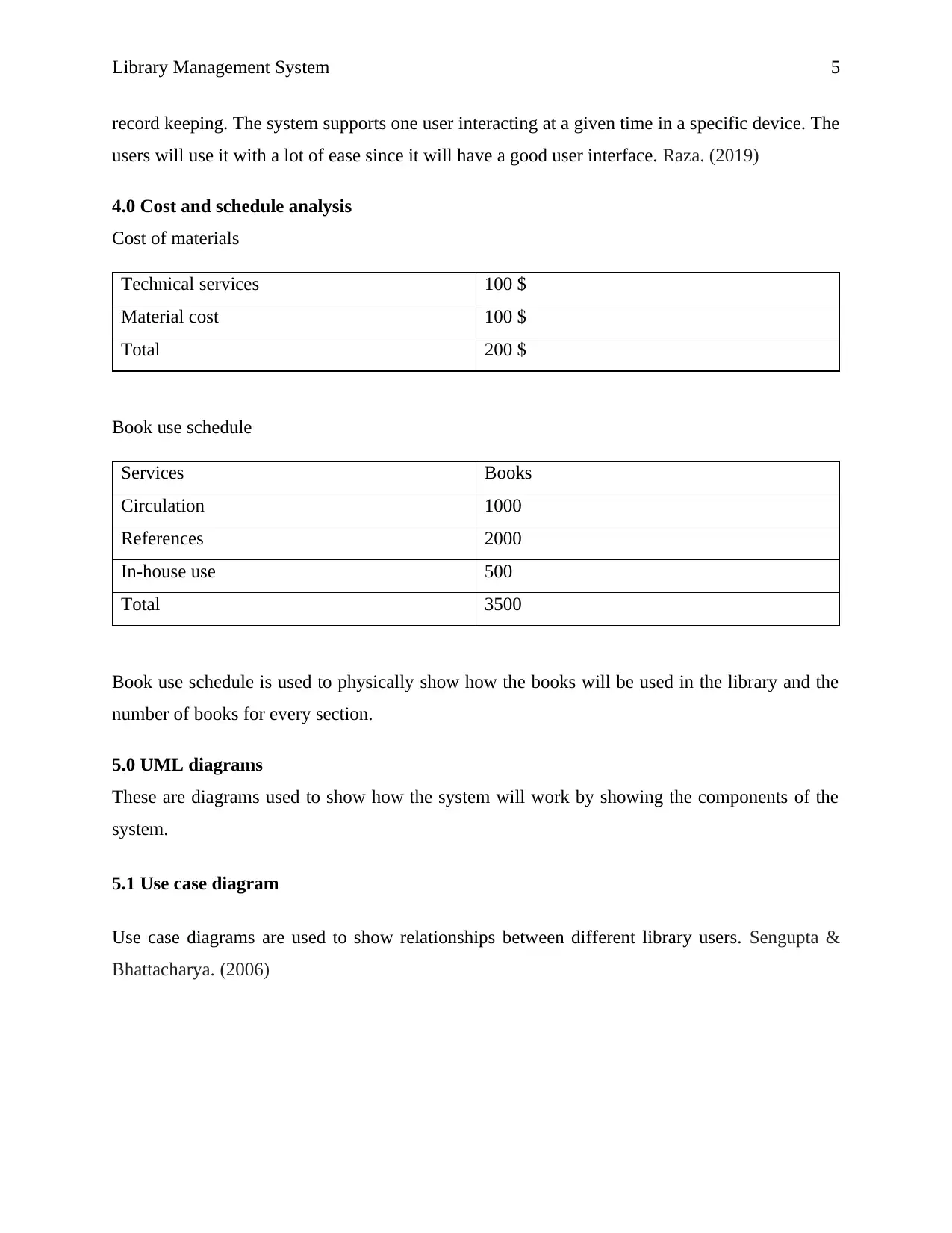
Library Management System 5
record keeping. The system supports one user interacting at a given time in a specific device. The
users will use it with a lot of ease since it will have a good user interface. Raza. (2019)
4.0 Cost and schedule analysis
Cost of materials
Technical services 100 $
Material cost 100 $
Total 200 $
Book use schedule
Services Books
Circulation 1000
References 2000
In-house use 500
Total 3500
Book use schedule is used to physically show how the books will be used in the library and the
number of books for every section.
5.0 UML diagrams
These are diagrams used to show how the system will work by showing the components of the
system.
5.1 Use case diagram
Use case diagrams are used to show relationships between different library users. Sengupta &
Bhattacharya. (2006)
record keeping. The system supports one user interacting at a given time in a specific device. The
users will use it with a lot of ease since it will have a good user interface. Raza. (2019)
4.0 Cost and schedule analysis
Cost of materials
Technical services 100 $
Material cost 100 $
Total 200 $
Book use schedule
Services Books
Circulation 1000
References 2000
In-house use 500
Total 3500
Book use schedule is used to physically show how the books will be used in the library and the
number of books for every section.
5.0 UML diagrams
These are diagrams used to show how the system will work by showing the components of the
system.
5.1 Use case diagram
Use case diagrams are used to show relationships between different library users. Sengupta &
Bhattacharya. (2006)
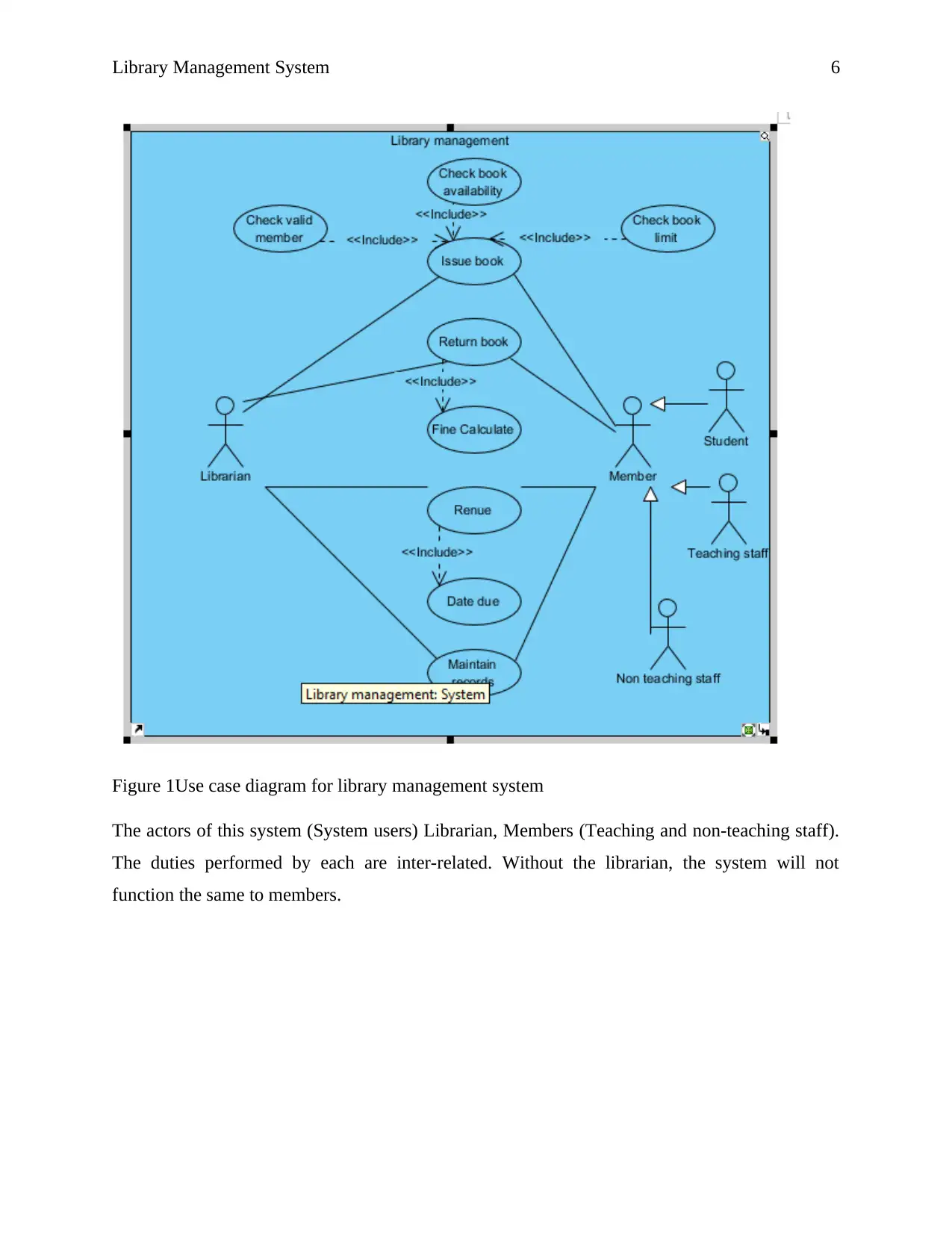
Library Management System 6
Figure 1Use case diagram for library management system
The actors of this system (System users) Librarian, Members (Teaching and non-teaching staff).
The duties performed by each are inter-related. Without the librarian, the system will not
function the same to members.
Figure 1Use case diagram for library management system
The actors of this system (System users) Librarian, Members (Teaching and non-teaching staff).
The duties performed by each are inter-related. Without the librarian, the system will not
function the same to members.
⊘ This is a preview!⊘
Do you want full access?
Subscribe today to unlock all pages.

Trusted by 1+ million students worldwide
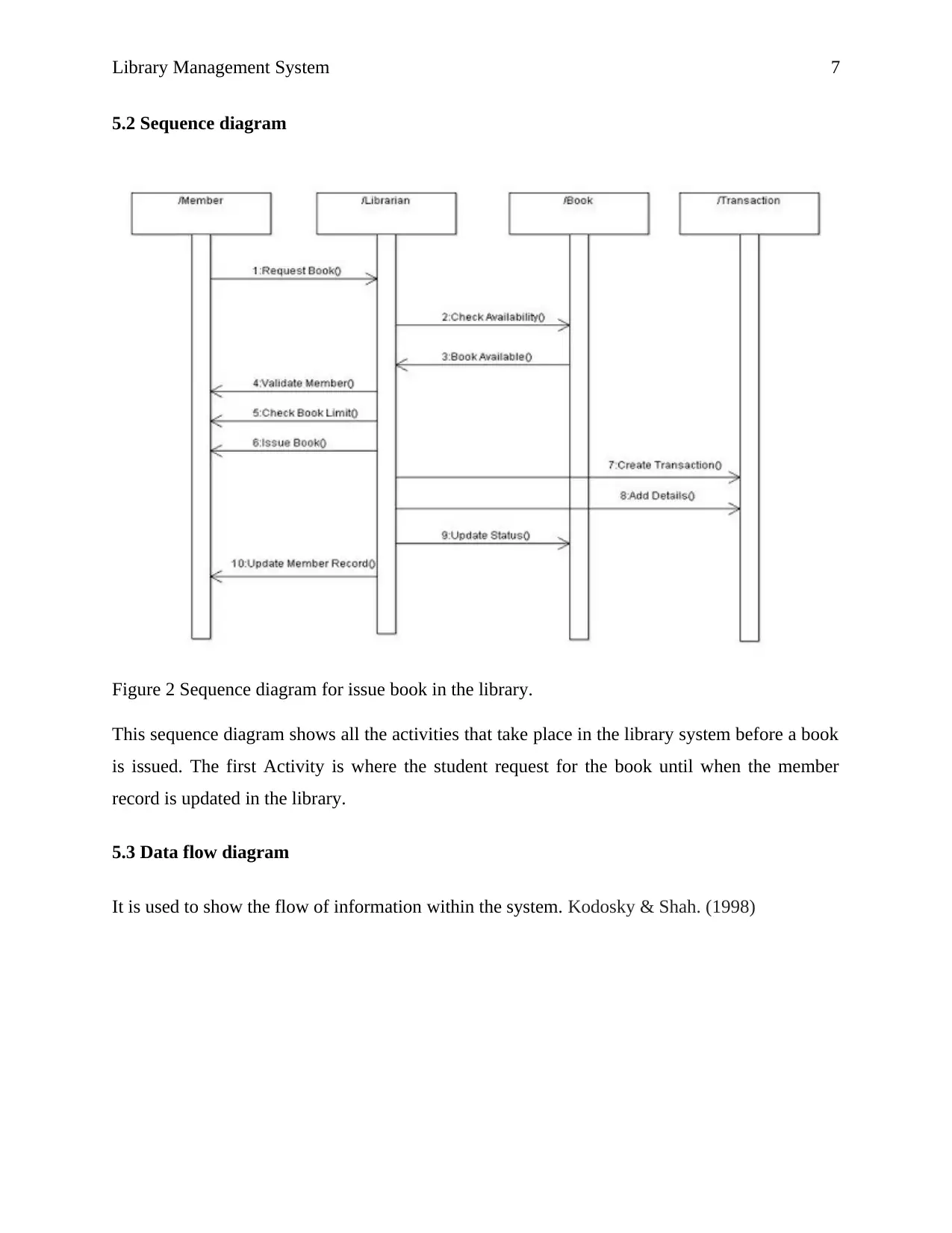
Library Management System 7
5.2 Sequence diagram
Figure 2 Sequence diagram for issue book in the library.
This sequence diagram shows all the activities that take place in the library system before a book
is issued. The first Activity is where the student request for the book until when the member
record is updated in the library.
5.3 Data flow diagram
It is used to show the flow of information within the system. Kodosky & Shah. (1998)
5.2 Sequence diagram
Figure 2 Sequence diagram for issue book in the library.
This sequence diagram shows all the activities that take place in the library system before a book
is issued. The first Activity is where the student request for the book until when the member
record is updated in the library.
5.3 Data flow diagram
It is used to show the flow of information within the system. Kodosky & Shah. (1998)
Paraphrase This Document
Need a fresh take? Get an instant paraphrase of this document with our AI Paraphraser
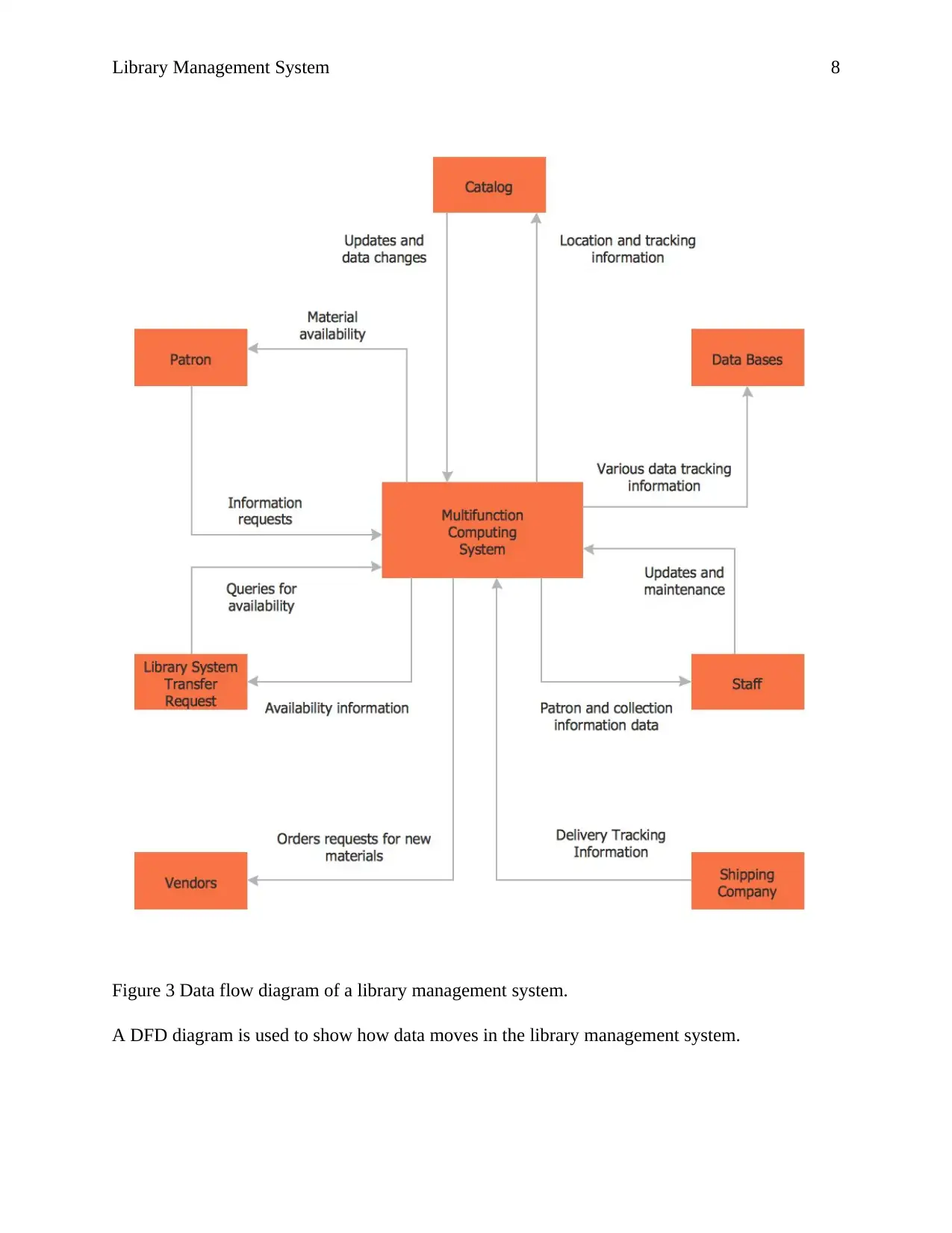
Library Management System 8
Figure 3 Data flow diagram of a library management system.
A DFD diagram is used to show how data moves in the library management system.
Figure 3 Data flow diagram of a library management system.
A DFD diagram is used to show how data moves in the library management system.
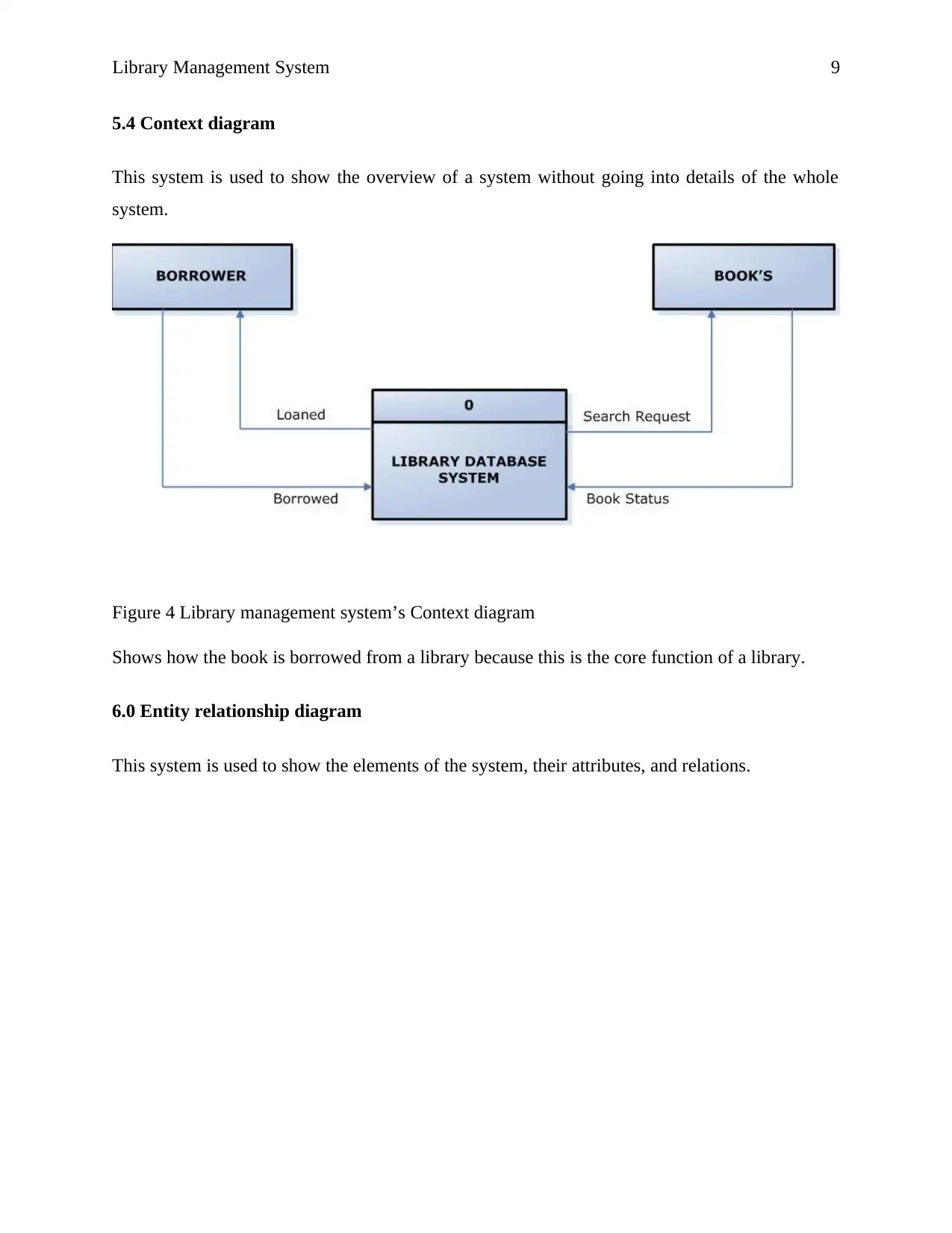
Library Management System 9
5.4 Context diagram
This system is used to show the overview of a system without going into details of the whole
system.
Figure 4 Library management system’s Context diagram
Shows how the book is borrowed from a library because this is the core function of a library.
6.0 Entity relationship diagram
This system is used to show the elements of the system, their attributes, and relations.
5.4 Context diagram
This system is used to show the overview of a system without going into details of the whole
system.
Figure 4 Library management system’s Context diagram
Shows how the book is borrowed from a library because this is the core function of a library.
6.0 Entity relationship diagram
This system is used to show the elements of the system, their attributes, and relations.
⊘ This is a preview!⊘
Do you want full access?
Subscribe today to unlock all pages.

Trusted by 1+ million students worldwide
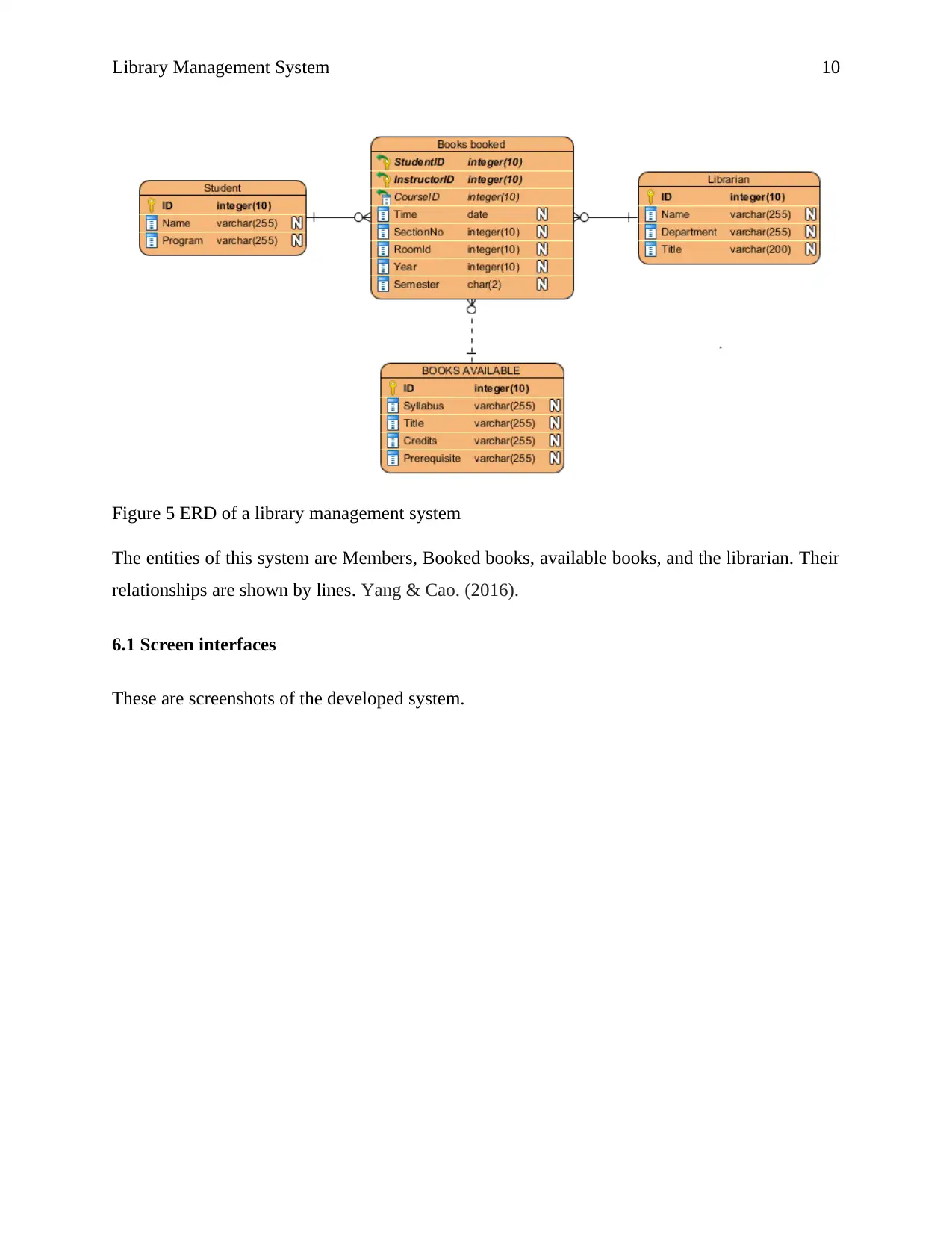
Library Management System 10
Figure 5 ERD of a library management system
The entities of this system are Members, Booked books, available books, and the librarian. Their
relationships are shown by lines. Yang & Cao. (2016).
6.1 Screen interfaces
These are screenshots of the developed system.
Figure 5 ERD of a library management system
The entities of this system are Members, Booked books, available books, and the librarian. Their
relationships are shown by lines. Yang & Cao. (2016).
6.1 Screen interfaces
These are screenshots of the developed system.
Paraphrase This Document
Need a fresh take? Get an instant paraphrase of this document with our AI Paraphraser
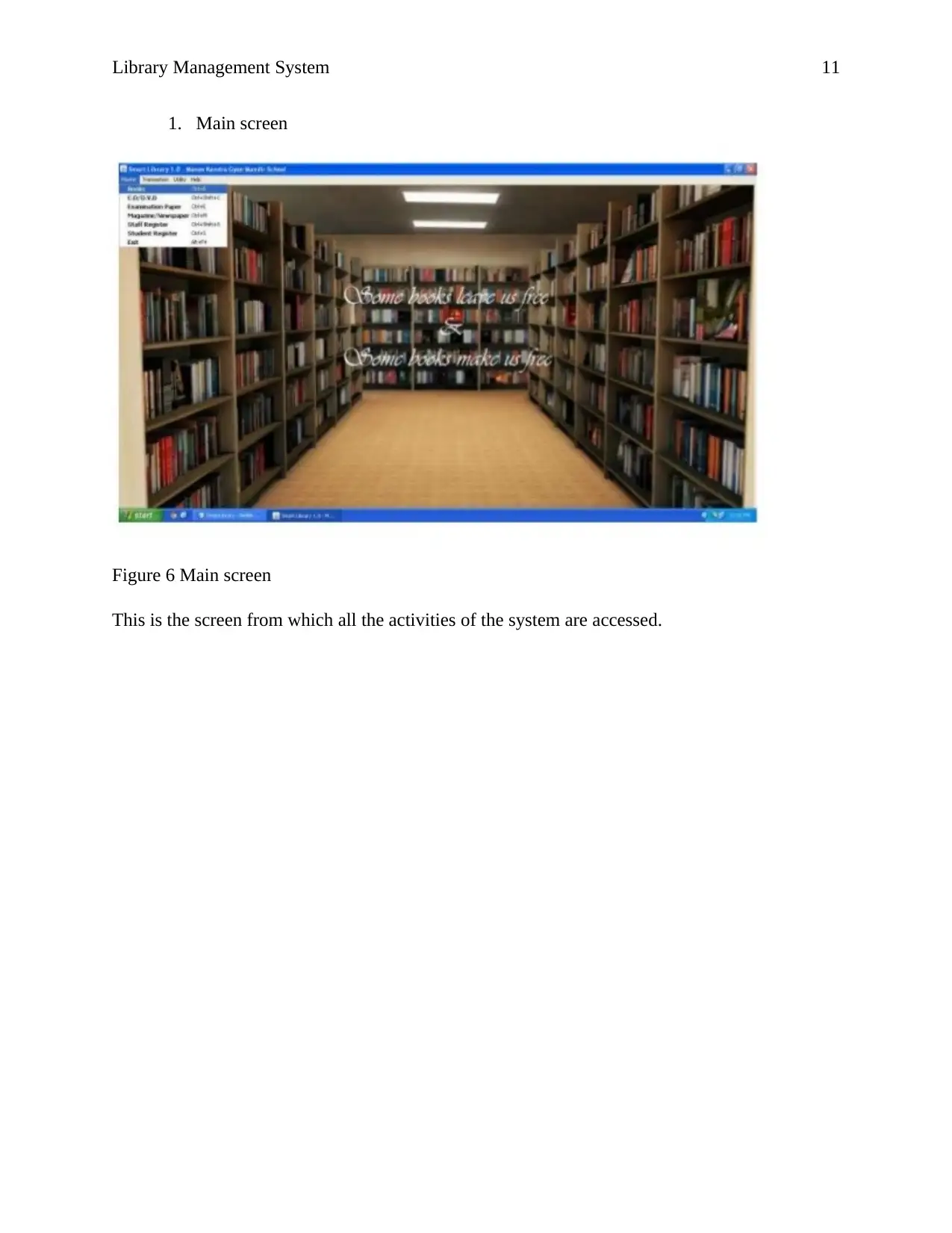
Library Management System 11
1. Main screen
Figure 6 Main screen
This is the screen from which all the activities of the system are accessed.
1. Main screen
Figure 6 Main screen
This is the screen from which all the activities of the system are accessed.
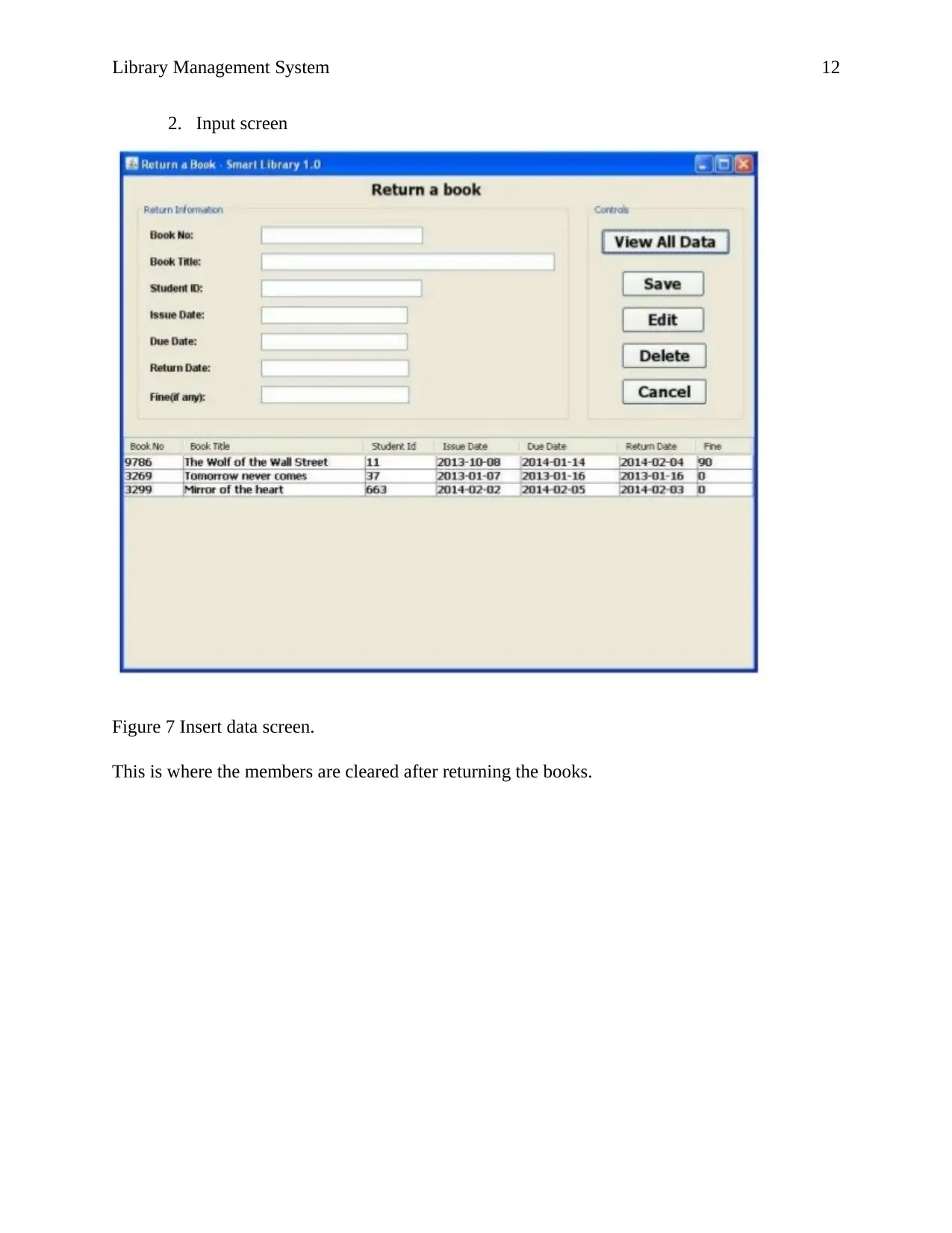
Library Management System 12
2. Input screen
Figure 7 Insert data screen.
This is where the members are cleared after returning the books.
2. Input screen
Figure 7 Insert data screen.
This is where the members are cleared after returning the books.
⊘ This is a preview!⊘
Do you want full access?
Subscribe today to unlock all pages.

Trusted by 1+ million students worldwide
1 out of 15
Related Documents
Your All-in-One AI-Powered Toolkit for Academic Success.
+13062052269
info@desklib.com
Available 24*7 on WhatsApp / Email
![[object Object]](/_next/static/media/star-bottom.7253800d.svg)
Unlock your academic potential
Copyright © 2020–2025 A2Z Services. All Rights Reserved. Developed and managed by ZUCOL.





